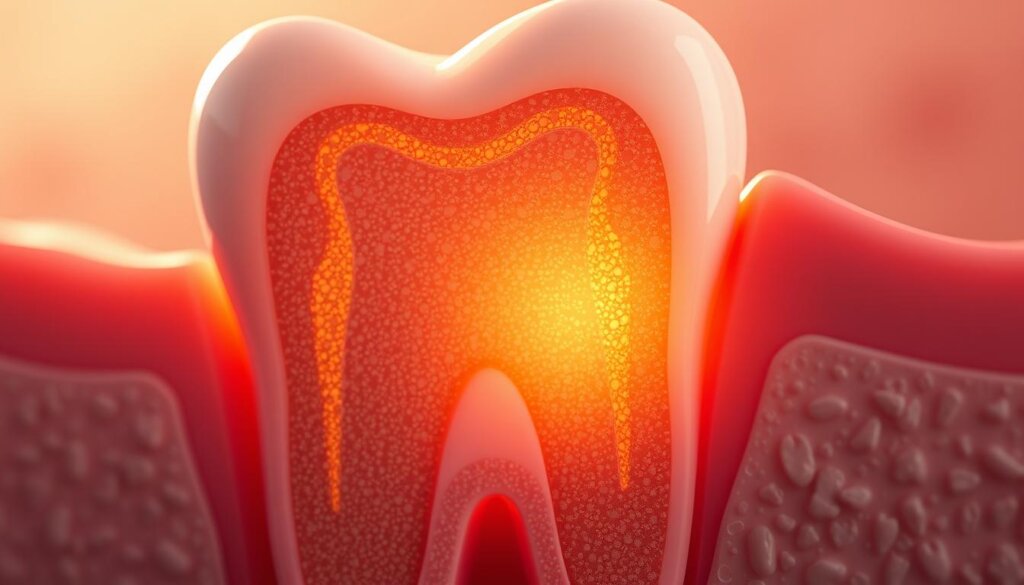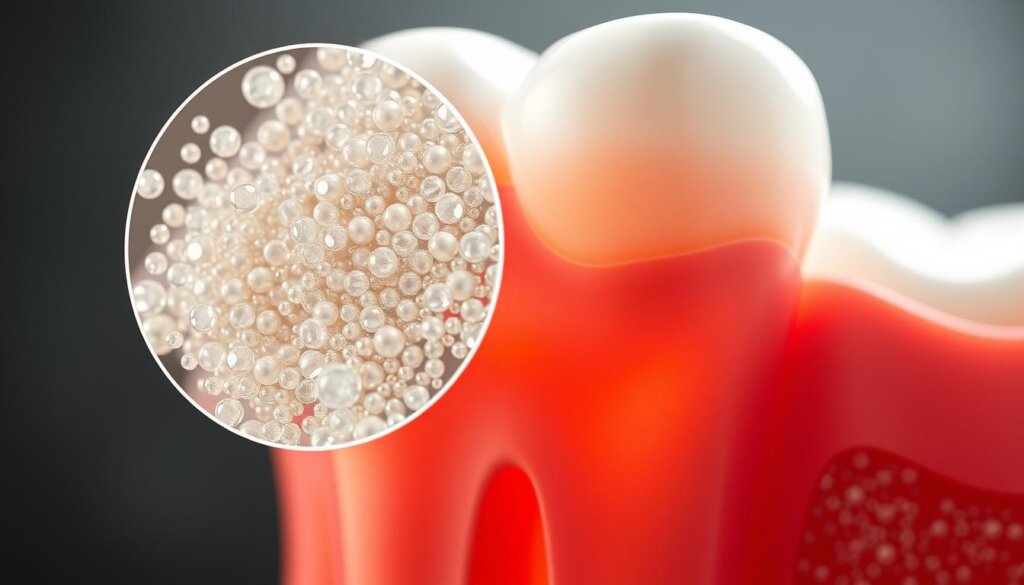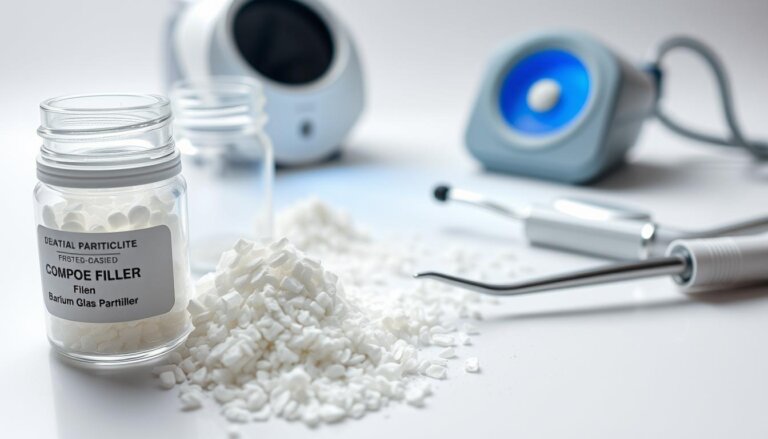What Are Composite Fillings Made Of?
A staggering 92% of adults aged 20 to 64 have had cavities in their permanent teeth, says the National Institute of Dental and Craniofacial Research. With such a high number, the need for composite dental fillings that look natural has shot up. But, what are composite fillings made of? These amazing fillings combine acrylic resin and fine glass particles. This mix makes tooth restorations strong and matches them with your natural teeth.
Unlike silver fillings, tooth-colored fillings are mercury-free. This is a big plus for people who worry about safety. The acrylic resin has glass quartz, silica, or ceramic particles added in. This mix looks good and is strong. Plus, these fillings don’t have the mercury vapor issue, which can harm brains and kidneys if levels are too high.
But, there’s more to these fillings. Some people worry about Bisphenol A (BPA) in them. Today’s dentistry often skips BPA in composite fillings. And if it’s used, the American Dental Association says it’s a tiny amount that’s safe. So, composite fillings are not just good-looking. They are also a safe option.
Key Takeaways
- Composite fillings, favored for their ability to match natural tooth color, consist primarily of acrylic resin and powdered glass-like materials.
- These fillings stand out as a mercury-free alternative, eliminating the health concerns associated with silver amalgam fillings.
- Designed for durability, composite fillings integrate seamlessly with tooth structure, thanks to their unique material blend.
- Most composite fillings exclude BPA, aligning with a preventative approach to patient health and safety.
- Given their composition and benefits, composite fillings represent a sophisticated choice for tooth restoration that prioritizes both aesthetics and health.
Understanding Composite Fillings
Composite fillings stand out because they look good and work well, a key part of today’s dental care. Their composite fillings composition mixes resin with fine glass particles. This mix makes them strong and look natural, matching the tooth’s color.
Not only do they fill cavities, but they also fix teeth worn down from grinding or cracked. A big benefit of composite fillings is they don’t need much of the tooth removed to work. This keeps your teeth strong and healthy while fixing them.
Definition and Purpose
Composite fillings do more than just fill holes in your teeth; they bring back your teeth’s look and work. They bond right to the tooth, giving it extra support. Thanks to the materials used in composite fillings, they can be made to match your tooth color perfectly, making your smile look great.
Advantages of Composite Fillings
There are many good points about using composite fillings in dental work. People love them because they match the natural color of teeth, making smiles look better. These fillings set quickly with a special light, making the dentist visit fast and easy. The benefits of composite fillings include making teeth stronger and less sensitive after dental work. They can be used for many different dental fixes, even big ones.
Components of Composite Fillings
In the world of fixing teeth, knowing what goes into composite fillings is key. These fillings are made from special materials. Each part adds benefits that make the fillings work better and look good.
The acrylic resin in the fillings holds everything together. It’s very important because it makes the filling strong and stick well to the tooth.
Things like powdered glass and ceramics are in composite fillings too. These parts make the filling strong. They help it look just like a real tooth.
There’s also something called silanes that help the different parts stick together better. This makes the filling last longer and stay stronger.
All these parts work together to create a filling that looks and works great. The mixing of resin, fillers, and silanes shows the smart design behind composite fillings. It’s all about getting the best results for patients.
Material Properties of Composite Fillings
Composite fillings have changed the way we restore teeth, blending looks and strength. They’re made to look just like tooth enamel but are tough enough for everyday use.
Aesthetic dental fillings look just like your real teeth, making them perfect for the teeth you see most. The strength of tooth-colored fillings stands out. They are durable against daily activities like chewing.
The durability of composite fillings means they last a long time. Still, taking good care of them is important. Their beauty and strength make them a top choice for those wanting a natural look and minimal fuss.
These fillings strike a balance between looking good and being strong. The tech behind them is always getting better. This ensures they not only look like your natural teeth but work just as well.
The Role of Resin in Composite Fillings
Today’s dentistry has seen major advancements in materials like composite dental fillings. These improvements offer strength and look good, thanks to acrylic resin. It plays a key role in making sure fillings are strong and look natural.
It’s useful to understand the types of resins used. This helps us see why dentists and patients often prefer these materials.
Types of Resins Used
The success of composite fillings largely depends on the resin quality. Resins like Bisphenol A-Glycidyl Methacrylate (BIS-GMA), Urethane Dimethacrylate (UDMA), and other methacrylates keep the filling together. These resins are chosen for their strong bonding and durability.
Benefits of Resin-Based Fillings
Resin offers more than a nice look in fillings. Its key advantage is that it sticks directly to the tooth. This means less drilling is needed, saving more of the natural tooth. This keeps the tooth strong and lasting long.
Resin’s ability to match tooth color makes fillings look natural, boosting the smile’s appearance.
In summary, using resin in dental fillings is a big leap forward. It lets dentists fix teeth in a way that is strong, reliable, and looks great. This showcases the progress in dental materials.
Common Filler Materials
Composite fillings are popular for their flexibility and good looks in fixing teeth. They work well because they use different types of filler materials. These materials are key because they decide how the fillings will act and how effective they will be.
Glass Ionomer
Glass ionomer fillings are special because they bond to tooth structures and prevent decay. They also release fluoride to protect against further damage. This is why they’re often chosen for their long-term benefits.
Quartz-Based Fillers
Quartz makes dental fillings strong and resistant to wear. This strength is important for areas of the mouth that handle a lot of force. Plus, quartz helps the fillings look more natural, meeting patients’ needs for looks as well as function.
Other Fillers
Apart from quartz and glass ionomer, fillings may also have silica and ceramics. These materials add benefits like shininess, matching the tooth’s appearance, and increased strength. They help make the fillings last longer and work better.
The Composition of Composite Resin
Understanding the mix of organic and inorganic materials in fillings shows why dentists often choose composite resin. These materials work together to make fillings both look good and work well.
The composite resin composition is made of different organic and inorganic parts. Each part has a special role that helps the resin do its job well. Let’s take a closer look at these materials.
Organic Components
The organic side of composite resin is mostly the resin matrix. This matrix keeps the resin flexible, which is key when it’s being put in place. It also helps the filling stick to the tooth, ensuring it lasts a long time.
Inorganic Components
On the other hand, the inorganic part has filler particles like glass and ceramics. These are chosen for their strength and ability to resist wear. The inorganic materials make the filling strong and long-lasting.
By blending these organic and inorganic parts, composite fillings look and feel like real teeth. They also stand up well to tooth decay and damage. This careful mix makes composite resin a top choice in dental care.
Comparing Composite Fillings to Other Types
In the world of dental fillings, it’s super important to know your options. The comparison of filling materials helps dentists choose the right one. It also lets patients understand what’s best for them. The differences between silver amalgam fillings and composite fillings, as well as between porcelain inlays and composite fillings, show how dental care meets various needs.
Silver Amalgam vs. Composite
Silver amalgam fillings are used for the back teeth because they are strong. They last long due to their metal parts. But, they don’t look like natural teeth because of their metallic color.
Porcelain Fillings vs. Composite
Porcelain inlays look a lot like real teeth and are durable. But getting them can take more than one dentist visit and cost more. They are great for teeth that show when you smile because they match so well.
Composite fillings are a good middle ground. They look good and match your teeth well. Though not as tough as silver amalgam or as perfect-looking as porcelain inlays, they work well for regular dental fixes. They can be done in one visit, saving time and money.
The Application Process for Composite Fillings
The process of applying dental fillings is crucial for their durability and look. It includes several key steps that help the filling work well and last long.
Preparation of the Tooth: First, the tooth is cleaned and decay is removed. It is then shaped to hold the filling tightly. This step is vital for making sure the tooth and filling bond well.
Composite Layering Technique: Filling the tooth uses a technique where resin is added in thin layers. Each layer is shaped to match the tooth’s natural shape, ensuring a tight fit. This also helps bring back the tooth’s look and function.
Curing Composite Fillings: Every layer of the composite needs to be hardened with a special light. This makes the filling stable and strong. It’s essential for the layers to bond well with the tooth.
Overall, the detailed process of applying dental fillings, including layering and curing, restores the tooth and improves its look. These steps are critical for a successful restoration that can make patients happy and keep their teeth healthy.
Maintenance of Composite Fillings
Keeping composite fillings in good shape is key to healthy teeth over time. Looking after your fillings helps them last longer and keeps your mouth healthy. By visiting the dentist regularly and taking care of your teeth at home, you can keep your fillings in tip-top condition.
Taking care of your fillings means following a strict oral hygiene routine. This includes actions that protect the look and strength of your fillings. Spotting any damage early on is crucial for fixing it quickly.
| Care Aspect | Description | Frequency |
|---|---|---|
| Brushing | Use a soft-bristled toothbrush and non-abrasive toothpaste to avoid scratching the surface of the fillings. | Twice daily |
| Flossing | Regular flossing helps remove plaque from between the teeth and around the fillings, reducing the risk of decay and prolonging the life of the filling. | Daily |
| Professional Cleaning | Regular visits to the dentist for professional cleaning help to remove tartar and plaque that regular brushing and flossing might miss. | Every 6 months |
| Regular Check-Ups | Regular dental check-ups allow the dentist to monitor the health of the fillings and surrounding teeth and gums. | Every 6 months |
Watch out for signs like cracks or changes in color in your fillings to keep them strong. Fixing small problems early helps stop larger ones later, maintaining the fillings and your overall dental health.
Longevity of Composite Fillings
The lifespan of composite fillings matters a lot for dentists and their patients. How long these fillings last depends on many factors, which have gotten better as dental science has advanced.
Knowing what affects the durability of dental fillings helps them last longer. This includes how the filling is done and the patient’s dental hygiene and habits.
Factors Affecting Lifespan
- Location and size of the filling: Fillings in molars that endure more chewing force may have a shorter lifespan.
- Quality of the dental procedure: Proper adhesion and correct placement techniques can prolong the life of the filling.
- Oral hygiene practices: Regular brushing and flossing, along with professional cleanings, are crucial.
- Eating habits: Hard foods and substances can compromise the integrity of composite fillings.
Average Duration of Composite Fillings
Once, composite fillings were thought to last five to seven years. But now, thanks to new dental materials and technologies, they can last much longer. If taken care of, many fillings now last more than ten years.
Sticking to good oral healthcare routines helps these fillings last longer. This way, patients can make the most of their dental health investment.
It’s crucial for patients to talk to their dentists about how long their treatment might last. This helps set clear expectations and plans for future care. Continuing this talk helps ensure the best dental health outcomes.
Cost Factors of Composite Fillings
Knowing the cost of composite fillings and how dental insurance coverage for fillings works is key for patients. This knowledge is important when deciding if this treatment is worth the money. Patients need to consider many things, including how much they will spend.
The price of fillings can change based on several factors. These include how bad the dental problem is, what materials are used, and the dentist’s skills. Where you live and the dentist’s pricing rules also affect the cost.
Insurance Considerations
Dental insurance might cover some of the cost for composite fillings. Yet, coverage varies a lot between plans. Most plans only cover part of the cost, seeing these fillings as basic care. It’s wise to check your insurance or talk to your provider to get the details on what’s covered and what you might have to pay.
Comparing Costs with Other Fillings
Looking at the cost of composite fillings versus other fillings shows different prices. These differences come from the materials, how much work is needed, and how long they last. Here’s a look at how composite fillings compare to other options:
| Filling Type | Initial Cost | Longevity | Aesthetic Quality |
|---|---|---|---|
| Composite | Medium | 5-10 Years | High |
| Amalgam | Lower | 10-15 Years | Low |
| Gold | High | 20+ Years | Medium |
| Porcelain | High | 15+ Years | High |
Even though composite fillings may cost more at first than amalgam ones, they look better and are less invasive. This could save you money on dental visits down the road.
The Environmental Impact of Composite Fillings
The importance of the environmental impact of dental fillings is growing. The dental industry is aiming for more green methods. Composite fillings are especially getting attention for being more eco-friendly and for recycling efforts. This is key for making dental care that doesn’t harm our planet much.
Using green materials helps our planet. It also meets the increasing demand for eco-conscious health care. These materials aim to shrink the amount of trash that won’t break down. This is important because composite fillings often contain plastics.
Improving recycling for composite fillings is crucial too. Being able to reuse and recycle dental materials can lessen their environmental impact. This change could greatly reduce the dental industry’s harm to the environment.
Choosing sustainable materials shows a dentist’s dedication to protecting our future. As studies continue, the goal is to discover options that provide good dental care without hurting the earth.
Innovations in Composite Fillings
The world of fixing teeth is seeing big changes, with dental filling innovation leading. New science is improving how fillings work, last, and look.
New materials are being made that could change tooth care for the better. They aim for fillings that last longer and match teeth better.
| Material Type | Properties | Applications |
|---|---|---|
| Bioactive composites | Supports remineralization, integrates with tooth structure | Restorative treatments, cavity fillings |
| Nanocomposite materials | Highly durable, improved aesthetics | Frontal restorations, surface repairs |
| Smart materials | Responsive to temperature, stress | Adaptive fillings, preventive care |
Future dental materials are changing tooth care for the better. They aim for treatments that last longer and are more effective. Nanotechnology is being used to make fillings stronger and more suited to each person’s needs.
New filling types are pushing what’s possible in dentistry. They show our dedication to improving tooth care with science and technology.
Conclusion: The Value of Composite Fillings
Composite fillings have greatly improved the way we fix teeth today. They blend perfectly with your natural teeth, making them a top choice for fillings. Their design lets dentists match them to your own tooth color.
These fillings are strong and last a long time, even though they might cost more at first. They are less painful to get because they don’t remove much of your tooth. And if you don’t want metal in your mouth, composites are a great option.
Choosing the right dental care means knowing all your options. Composite fillings are good because they look nice and are strong. Making a choice like this can help keep your teeth healthy for a long time. Think about what matters most to you in dental care before making a decision.







